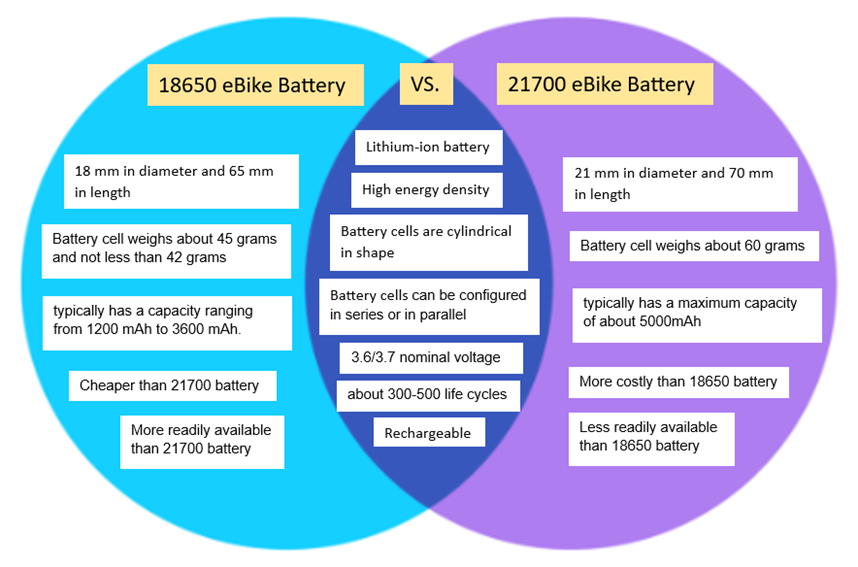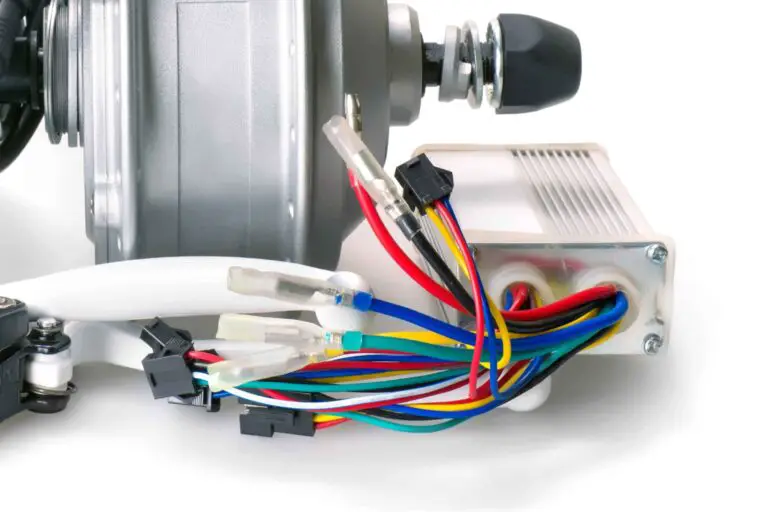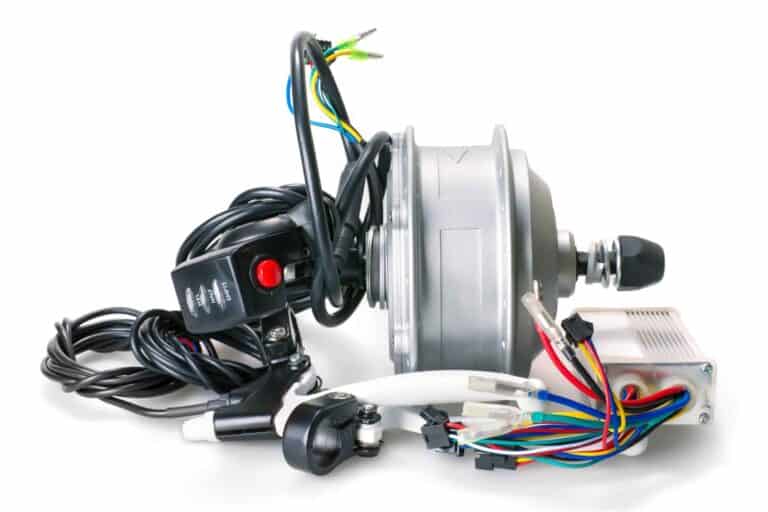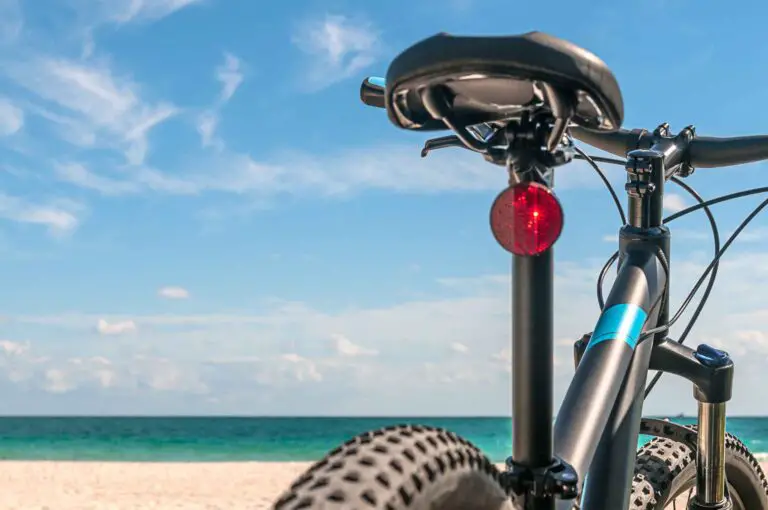18650 Battery Vs. 21700 eBike Battery (A Helpful Chart)
Most electric bikes nowadays are equipped with lithium-ion batteries, with some of them being made of either 18650 or 21700 lithium-ion cells. As e-bike riders, we often seek e-bike batteries that offer the best performance and efficiency. So, when choosing between an 18650 and a 21700 battery, which one is the better option to use?
As a general rule, both the 18650 and 21700 batteries are lithium-ion batteries that offer reliable performance. These battery types are commonly used in various electronic devices, including electric bikes, and are known for their rechargeable nature.
As a whole, a 21700 battery is larger than an 18650 battery. The 18650 battery measures 18 mm in diameter and 65 mm in length, while the 21700 battery is 21 mm in diameter and 70 mm in length. Due to their larger size, 21700 battery cells typically have more capacity.
As a whole, when it comes to more prolonged use or run-time, the 21700 battery is a better choice due to its higher capacity. However, 18650 battery cells are easier to find and tend to be cheaper than their 21700 counterparts.
When purchasing an electric bike, the quality of the battery is a significant consideration for most riders. In this article, we will explore the distinctions and similarities between 18650 and 21700 batteries and address common related questions so that you make the best choice for you.
18650 eBike Battery Vs. 21700 eBike Battery
| eBike Battery | 18650 eBike Battery | 21700 eBike Battery |
| Cost of Purchase | Cheaper than 21700 e-bike battery | More expensive than the 81650 e-bike battery |
| Maintenance Cost | $0 | $0 |
| Running Cost | A bit lower | A bit higher |
| Range | A bit shorter | A bit longer |
| Reliability | Equally reliable | Equally reliable |
| Lifespan | 300-500 life cycles | 300-500 life cycles |
Cost of Purchase: 18650 eBike Battery Vs. 21700 eBike Battery
In most cases, the price of the 18650 battery cell is slightly cheaper than the 21700 battery. However, the actual price of the e-bike battery pack will depend on the battery’s overall performance, brand, and capacity. Battery cells manufactured by reputable brands would likely cost more. Moreover, the overall technology integrated into the battery pack can also make a difference. For those battery packs, whether made of 18650 or 21700 battery cells but featuring advanced technology with enhanced safety and security features, the cost would likely be higher. Furthermore, the total capacity of the e-bike battery pack depends on the battery configuration. In most cases, e-bike battery packs, whether composed of 18650 or 21700 battery cells but configured for higher capacity, would likely come at a higher cost.
Here are some 18650 and 21700 batteries you can purchase:
| eBike Battery | Battery Cells Used | Cost of Purchase |
| 52V 50-AMP 25AH Mega Shark eBike Battery | 21700 | $695 |
| 52V 40-AMP 14AH Super-Shark eBike Battery | 21700 | $495 |
| FcotMiue 72V 20Ah Ebike Battery 1440Wh 21700 Lithium ion eBike Battery | 21700 | $729.99 |
| Unit Pack Power Samsung LG 21700 Ebike Battery Pack – Electric Bike Battery Pack | 21700 | $578.68 |
| 48V Ebike Battery with USB Connector Hailong Down Tube | 18650 | $250 |
| 52V Triangle Lithium Battery | 18650 | $285 |
| E-Bike Battery 36V 13Ah HaiLong Down Tube | 18650 | $165 |
| H HAILONG Ebike Battery 48v 20ah Li-ion Battery Pack | 21700 | $379.99 |
Maintenance Cost: 18650 eBike Battery Vs. 21700 eBike Battery
Generally, maintaining your electric bike battery, whether made of 18650 or 21700 battery cells, will cost you as little as $0. Battery maintenance includes proper usage and charging. When riding in muddy or wet terrain, you can simply clean your battery’s exterior by wiping off the dirt using a dry cloth.
However, suppose there is a problem with your electric bike battery that requires assistance from a professional mechanic. In that case, you will need to pay for the service, which will likely cost around $150, depending on the complexity of the issue with your battery. Moreover, if the battery is no longer working and replacement is needed, the cost will depend on the specific e-bike battery model.
Running Cost: 18650 eBike Battery Vs. 21700 eBike Battery
Typically, since a 21700 battery has a higher capacity, it will likely have higher running costs than an 18650 battery because it will take longer to charge. However, since an 18650 battery has a lower capacity, it will probably have a shorter running time, leading to more frequent charges than a 21700 battery. In short, the 18650 battery will charge faster but more frequently, while the 21700 takes longer to charge but requires less frequent charging. Additionally, if two e-bike battery packs, one made of 18650 cells and the other of 21700 cells, have configurations that result in the same total capacity, their running and charging costs would likely be the same.

Range: 18650 eBike Battery Vs. 21700 eBike Battery
In most cases, an e-bike battery made of 21700 battery cells will likely have a more extended range than the e-bike battery with 18650 battery cells. That is because 21700 batteries can store much more energy than 18650 batteries. However, it is essential to note that the overall range of the electric bike does not only depend on its capacity. The range of the electric bike can be affected by several factors such as speed, riding style, total weight carried, weather, and type of terrain.
Reliability: 18650 eBike Battery Vs. 21700 eBike Battery
Regarding reliability, 21700 and 18650 electric bike batteries are on par. They are both made of lithium-ion and work really well when used in electric bikes. The key difference is that 21700 batteries can hold much more energy. Therefore, when two e-bike battery packs made of 21700 and 18650 battery cells are configured similarly (with the same number of cells in series and parallel), the battery with 21700 cells can achieve the highest possible capacity. This allows you to ride for an extended period.
Lifespan: 18650 eBike Battery Vs. 21700 eBike Battery
Both 18650 and 21700 batteries typically have an average lifespan of about 300 to 500 charge cycles, which equates to roughly three years or more of usage. This lifespan is defined by the number of complete discharge/ charge cycles a battery can undergo before it loses efficiency. The longevity of an electric bike battery is contingent on its quality and the level of maintenance it receives. Therefore, if you desire a long-lasting e-bike battery, it’s essential to invest in a high-quality battery and diligently maintain it.
Differences and Similarities Between an 18650 eBike Battery and a 21700 eBike Battery
Pros and Cons of 18650 eBike Battery
| Pros of 18650 eBike Battery | Cons of 18650 eBike Battery |
| An 18650 battery is known for its high energy density, which means it can store much energy in a compact form. This feature makes them suitable for electric bikes, where weight and space are important factors. | Unlike other battery types, the 18650 lithium-ion battery is somewhat expensive. |
| On average, the 18650 battery will last for about 300-500 life cycles, which means it will likely take about 300 to 500 full discharge and charge cycles for the 18650 to lose its performance. | The 18650 battery has a limited shape, being only cylindrical. As a result, it may not be suitable for certain applications that require custom shapes or non-standard form factors. |
| The 18650 battery is known to be used in various electrical devices, including electric bikes. When used in e-bikes, a certain number of 18650 battery cells are packed together to create one e-bike battery with a specific voltage and amp-hour. | The volume of the 18650 lithium-ion battery is that its volume is fixed, so it cannot be altered and customized. |
| It has a high safety performance, reducing the risk of short circuits. | While 18650 e-bike batteries have a capacity of 1200 mAh to 3600 mAh, their capacities are smaller than 21700 e-bike batteries. |
| The 18650 battery typically has a capacity ranging from 1200 mAh to 3600 mAh. | One 18650 battery cell weighs about 45 grams and not less than 42 grams, so when used in e-bike battery packs, the weight may exceed 2 kg. |
| The 18650 battery has no memory effect, so you don’t have to go through a full discharge/charge cycle each time. In fact, when used in e-bikes, it is recommended to recharge the battery if it reaches 30-40% and charge do full discharge/charge once in a while. This increases the life span. | |
| The 18650 lithium-ion batteries can be placed in series or parallel, allowing them to achieve a high capacity. |
Pros and Cons of 21700 eBike Battery
| Pros of 21700 eBike Battery | Cons of 21700 eBike Battery |
| A 21700 battery is known for its high energy density, which means it can store a large amount of energy in a compact form. This feature makes them suitable for electric bikes, where weight and space are important factors to consider. | In comparison to some other battery types, 21700 lithium-ion batteries are often somewhat more expensive, and they may have a higher cost compared to 18650 batteries. |
| Like the 18650 battery, a 21700 battery will likely last for about 300-500 life cycles, which means it will take approximately 300 to 500 full discharge and charge cycles before it loses its performance. | The 21700 battery has a limited shape, being only cylindrical. As a result, it may not be suitable for certain applications that require custom shapes or non-standard form factors. |
| The 21700 battery is known to be used in various electrical devices, including electric bikes. | The volume of the 21700 lithium-ion battery is that its volume is fixed, so it cannot be altered and customized. |
| It has a high safety performance, reducing the risk of short circuits. | The 21700 batteries are larger than the 18650 batteries. They typically have a diameter of about 21 mm and a length of around 70 mm, which makes them physically bigger. |
| The 21700 battery typically has a maximum capacity of about 5000mAh, much higher than the 18650 battery. | The 21700 battery cells are larger and heavier than the 18650 cells, making the overall e-bike battery pack heavier when using 21700 cells. |
| The 21700 battery has no memory effect, so you don’t have to go through a full discharge/charge cycle each time. In fact, when used in e-bikes, it is recommended to recharge the battery if it reaches 30-40% and charge do full discharge/charge once in a while. This increases the life span. | |
| The 21700 lithium-ion batteries can be configured in series or parallel, allowing for a flexible approach to achieving high capacity while maintaining the desired voltage and current output. |
Are 21700 Batteries Better than 18650?
As a whole, 21700 batteries outperform 18650 batteries in terms of capacity. This is because a 21700 battery can reach a maximum capacity of 5000mAh, while the typical capacity of an 18650 battery ranges from 1200mAh to 3600mAh.
21700 and 18650 batteries are lithium-ion batteries known for their high efficiency, incredible performance, and excellent reliability. Both 21700 and 18650 battery cells are cylindrical but have different sizes. Although 21700 and 18650 batteries are efficient and reliable, 21700 batteries excel in terms of capacity. Due to their higher capacity than 18650 batteries, they can store more energy, allowing electrical devices like electric bikes to last longer on a single charge.
Does 21700 Last Longer than 18650?
On average, 21700 batteries typically last longer than 18650 batteries in terms of their runtime. When it comes to their lifespan, both 21700 and 18650 batteries can last about 300-500 life cycles and are likely to last even longer with proper use and maintenance.
Regarding their running time, the 21700 batteries will run longer on a single charge. 21700 batteries are bigger in size than 18650 batteries, allowing 21700 batteries to store much more energy than 18650 batteries. Since they have higher capacity, they likely have a longer runtime per charge.
“Batteries are the most dramatic object. Other things stop working, or they break, But Batteries… They Die.” -Demetri Martin
Can I Use a 21700 Battery Instead of an 18650?
As a general rule, using a 21700 battery instead of an 18650 depends on device compatibility, given their size differences. The 21700 cell is larger, measuring 21 mm in diameter and 70 mm in length, while the 18650 is smaller at 18 mm in diameter and 65 mm in length.
For example, if you plan to replace 18650 battery cells in your e-bike battery pack with 21700 cells, you might need help. The 21700 cells are significantly larger and have higher capacity. One issue is whether the 21700 cells will fit within the e-bike battery pack’s designated space intended for 18650 cells. Another consideration is that using 21700 cells instead of 18650 could alter the configuration of battery cells, potentially resulting in a significantly greater total capacity in the 21700 battery pack.
When it comes to battery replacement, changing your battery pack from 18650 cells to 21700 cells is a decision that rests with the manufacturer. Always consult with your electric bike’s manufacturer to determine if such changes are compatible.
If you want to assemble your e-bike battery pack using 21700 battery cells, watch the video below as a guide.
How Many mAh is 21700 Battery?
On average, the 21700 has a mAh ranging from about 3000 up to 5000, which is much higher than the energy that an 18650 battery can store. As a result, they are likely to provide more prolonged operation, making them advantageous for use in various electrical devices, including e-bikes.
Compared to 18650 batteries, 21700 batteries are larger, measuring about 21 mm in diameter and 70 mm in length, which allows them to store a much higher amount of energy. With this higher capacity, you will likely use any of your electric devices, such as electric bikes, for a more extended period on a single charge.
However, the overall capacity of an e-bike battery pack still depends on the configuration of the battery cells. In cases where there are two battery packs with the same configuration, one using 18650 cells and the other using 21700 cells, the battery pack with 21700 will typically last longer, enhancing your e-bike riding experience.
What Battery is Equivalent to 18650?
As a whole, batteries that are equivalent to the 18650 include the 21700 and 20700 batteries. These battery cells are made of lithium-ion and are known for their reliability and efficiency. The primary difference between them lies in their sizes.
The 21700, 20700, and 18650 batteries are all lithium-ion batteries, but the primary difference between them is their sizes. These lithium-ion batteries are named based on their sizes. The first two numbers represent their diameters, the following two numbers represent their lengths, and the last number signifies their cylindrical shape. Hence, 18650 batteries have a diameter of 18 mm and a length of 65 mm, 20700 batteries have a diameter of 20 mm and a length of 70 mm, and 21700 batteries have a diameter of 21 mm and a length of 70 mm.
These batteries typically have a nominal voltage of 3.6/3.7 Volts but differ in maximum capacities. Therefore, if you intend to use a different lithium-ion battery instead of an 18650 battery, it’s crucial to consult the manufacturer for compatibility to ensure your device functions safely and effectively.
Can a 18650 Charger Charge 21700?
As a general rule, you can charge a 21700 battery using an 18650 charger as long as the charger fits and is compatible with the battery pack. Before doing so, consult your electric bike manufacturer to confirm if this is feasible.
We always recommend using a charger that is intended for use with your electric bike. However, if you don’t have the proper charger and you have a charger for 18650 batteries, you can check if the charger works when used with your 21700 e-bike battery pack. It is important to note that using a charger not intended for your e-bike battery may be unsafe, so ensure you exercise due diligence when charging a 21700 battery with an 18650 charger.
In case you encounter an issue with your electric bike battery, you can visit our article “E-bike Battery Problems (A Fix That Actually Works)” for insightful tips that work.






